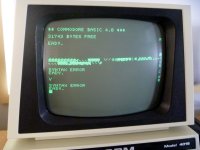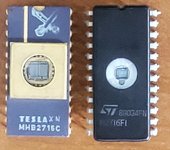A4000Bear
Experienced Member
I was attempting to replace the character ROM with an EPROM in my 4032, and every attempt results in corrupt characters or screen layout. The severity depends on what brand of EPROM I use, and is consistent within different EPROMS of the same brand/type. For example, using any 2716 made by ST results in the entire screen shifted one character to the left, the leftmost character is now on the right of the screen. Disregard the two lines of odd characters, they were the point of attempting to change the character ROM.

Other EPROMS gave even worse results.
In an attempt to isolate the problem, I tried reading the existing character ROM, and then burning its contents to various different brands of 2716 as well as several TI 2516s. All failed. All these EPROMs burn correctly and all pass the programmer's verify test. I should also point out the 4032 works perfectly with the original character ROM, and that I have previously sucessfully used EPROMS when replacing other ROMs in that machine.
A quick check on all the pins with an oscilloscope didn't reveal any obvious problems, however, a closer look revealed this on pin 10 (D1).

Replacing the original (working) Commodore ROM gives this:

Other data pins also have these spurious pulses when an EPROM is used. Sometimes these pulses are only 2 volts, but most of the time they are a bit over 4V. As you would expect, with EPROMs that have more corruption, there are more of these extra pulses. Power in the 4032 is at 5V and is clean.
Has anyone successfully used an EPROM to replace the character ROM in their 4032?

Other EPROMS gave even worse results.
In an attempt to isolate the problem, I tried reading the existing character ROM, and then burning its contents to various different brands of 2716 as well as several TI 2516s. All failed. All these EPROMs burn correctly and all pass the programmer's verify test. I should also point out the 4032 works perfectly with the original character ROM, and that I have previously sucessfully used EPROMS when replacing other ROMs in that machine.
A quick check on all the pins with an oscilloscope didn't reveal any obvious problems, however, a closer look revealed this on pin 10 (D1).

Replacing the original (working) Commodore ROM gives this:

Other data pins also have these spurious pulses when an EPROM is used. Sometimes these pulses are only 2 volts, but most of the time they are a bit over 4V. As you would expect, with EPROMs that have more corruption, there are more of these extra pulses. Power in the 4032 is at 5V and is clean.
Has anyone successfully used an EPROM to replace the character ROM in their 4032?

